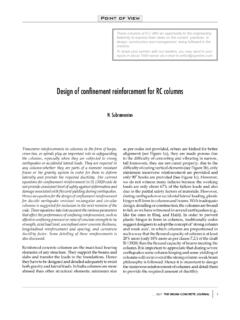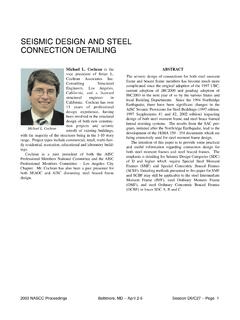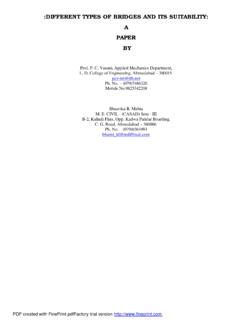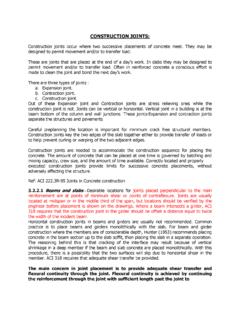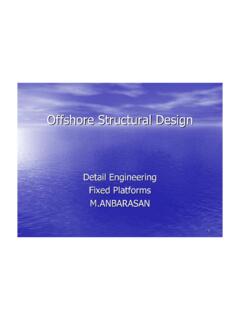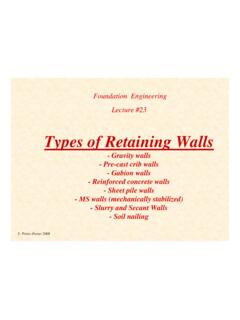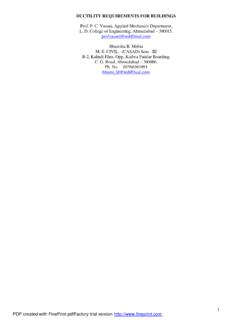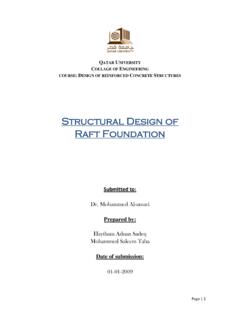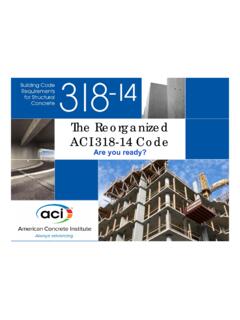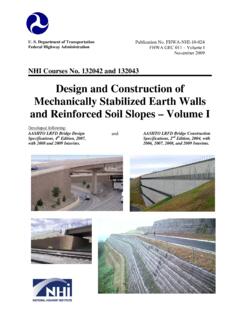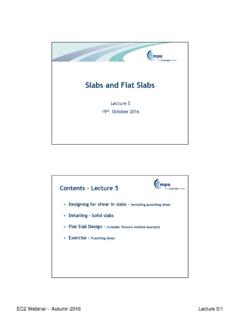Transcription of REINFORCEMENT HANDBOOK - Structural Engineers
1 REINFORCEMENT . HANDBOOK . YOUR GUIDE TO. STEEL REINFORCEMENT . R. This document is issued by The Australian Steel Company (Operations) Pty Ltd ABN 89 069 426 955 trading as The Australian Reinforcing Company ( ARC'). ARC National Office 518 Ballarat Road Sunshine VIC 3020 Australia Copyright ARC 2008. First published 1991. Second Edition 2001. Third Edition 2004. Fourth Edition 2007. Fifth Edition 2008. All rights reserved. No part of this publication may be reproduced, stored in a retrieval system or transmitted in any form or by any means, electronic, mechanical, photocopying, recording or otherwise, without the prior written permission of ARC. Every attempt has been made to trace and acknowledge copyright but in some cases this has not been possible. The publishers apologise for any accidental infringements and would welcome any information to redress the situation.
2 The information and illustrations in this publication are provided as a general guide only. The publication is not intended as a substitute for professional advice which should be sought before applying any of the information to particular projects or circumstances. In the event of purchase of goods to which this publication relates, the publication does not form part of the contractual arrangements with ARC. The purchase of any goods is subject to the ARC. Conditions of Sale. ARC reserves the right to alter the design or discontinue any of its goods or services without notice. Whilst every effort has been made to ensure the accuracy of the information and illustrations in this publication, a policy of continual research and development necessitates changes and refinements which may not be reflected in this publication.
3 If in doubt please contact your nearest ARC sales office. ARC - REINFORCEMENT HANDBOOK Preamble This HANDBOOK is the latest of many publications, since the 1920s, from ARC. It has the continuing objective of providing engineering details and properties of REINFORCEMENT available throughout Australia, together with an interpretation of the requirements of Australian Standards within the context of practical solutions. The information is considered to be of value to all who work in the Structural design and construction industry in a design office, on a construction site or a student preparing to enter the industry. There is considerable emphasis on the requirements of many Australian Standards. Standards are changing continuously to ensure that the latest practices are included.
4 It is hoped that this publication will retain its relevance for several years, given that the major standards for reinforcing steel and reinforced concrete design have been recently released. ARC - REINFORCEMENT HANDBOOK Contents Australian Codes, Standards and Glossary of General REINFORCEMENT ..3. REINFORCEMENT Production REINFORCEMENT Material Property ARC Product Reinforcing Bar Cutting Bars to Bending REINFORCEMENT to Welding Mechanical Rust and Protective 21. Quality Assurance and Quality 24. Tolerance on Bar 26. Information from 27. Clause Clause Information on Cover to Reinforcing Section 4 Cover for Section 5 Cover for Fire Clause Properties of Clause Class L Clause Material and Construction Requirements for Reinforcing Clause Tolerance on Position of Reinforcing 35.
5 Bar General Bar Tension Lap Length and Bar Compression Lap Length and 47. Additional Information On Lap Bar Hooks and Reinforcing 53. Mesh General Cross-Sectional Area of ARC Physical Dimensions of ARC Wire and Fabric Development Mesh 57. Special Fabric Design Appendix A Area Comparison Table Grade D500L Mesh and D500N Appendix B ARC Bar Bending Appendix C Refurbishment of Appendix D Metric and Imperial Bars and 67. Appendix E REINFORCEMENT Bar Chairs and ARC - REINFORCEMENT HANDBOOK Page D ARC - REINFORCEMENT HANDBOOK Introduction The REINFORCEMENT HANDBOOK provides information about the use of steel REINFORCEMENT when embedded in plain' concrete, in normal reinforced concrete or in prestressed concrete. Other information includes guidance on some applicable Australian Standards, design and construction tolerances, fabrication of REINFORCEMENT and tabulated data on fabric and bars.
6 The major source of information is AS3600-2001, the Concrete Structures Standard. To design and detail concrete structures correctly, the reader will need access to several other books and reference manuals. Some suggestions are given in the following pages. Recycling and restoration of older buildings is becoming more and more economical so that modern design techniques, combined with knowledge of the condition of the building, enable the existing reinforced concrete to be used with only minor modifications. For this reason, historical data is given in Appendix C, Refurbishment of Buildings. Figure 1: REINFORCEMENT cut, bent and bundled for delivery to site Figure 2: REINFORCEMENT being tied on site ARC - REINFORCEMENT HANDBOOK Page 1. Australian Codes, Standards and References Standards Australia is responsible for preparing and publishing those standards that relate to building materials and design.
7 In the preparation of this HANDBOOK , it has been assumed that the user will have access to a copy of the relevant standards. All building construction within each state and territory is controlled by its relevant building regulations. Cross-references to other Australian Standards incorporates them into the regulations. The Building Code of Australia, first published in 1988, was originally intended to provide uniformity of design and construction throughout Australia. Because each state and territory can incorporate its own special rules, designs prepared outside your state may require checking because of differing interpretations. Other national bodies such as the Steel REINFORCEMENT Institute of Australia (SRIA), the Cement and Concrete Association (C&CA) and Austroads prepare information helpful to the design of reinforced and prestressed concrete.
8 Further information may be obtained from the appropriate organisation in each state. Ref. No. Title of Standard Reference Date AS3600 Concrete Structures Standard (2001). AS3600 Supp1 Supplement No. 1 Commentary on AS3600 (being revised) (1994). AS/NZS 4671 Steel Reinforcing for Concrete (2001). Hot-Rolled Structural Steel Bars and Sections (1996). AS1391 Methods for Tensile Testing of Metals (2007). Structural Steel Welding Code - Welding of Reinforcing (2008). AS4680 Hot-Dipped Galvanised (Zinc) Coatings on Fabricated Ferrious Articles (2006). AS/NZS 4534 Zinc and Zinc/Aluminium-Alloy Coatings on Steel Wire (2006). ASTM A775M Epoxy Coated Steel Reinforcing Bars, ASTM, Philadelphia, USA (2001). ASTM A934M Epoxy Coated Steel Prefabricated Reinforcing Bars, ASTM, Philadelphia, USA (2001).
9 AS2783 Concrete Swimming Pools Code (1992). AS2870 Residential Slabs and Footings - Construction (2003). AS3850 Tilt-Up Concrete Construction (2003). AS/NZS Technical Drawing - Structural Engineering Drawing (2002). AS3610 Formwork for Concrete (1995). AS/NZS9001 Quality Management Systems (2000). AS5100 Bridge Design Specification (2004). Table 1: Australian Standards relevant to steel REINFORCEMENT (as at November 2008). 1. " REINFORCEMENT detailing HANDBOOK , Concrete Institute of Australia, Sydney, 1988. 2. Concrete Design HANDBOOK , Cement and Concrete Association of Australia, Sydney, 1989. 3. Design and Analysis of Concrete Structures , Fairhurst and Attard, McGraw-Hill, 1990. 4. Concrete Structures , Warner, Rangan, Hall and Faulkes, Longman, 1998. 5. After-Fabrication Hot Dip Galvanizing , Galavanizers Association of Australia, Melbourne, Australia, 1999.
10 6. Two Hundred Years of Concrete in Australia , Concrete Institute of Australia, Sydney, 1988. 7. Guidelines for Economical Assembly of REINFORCEMENT , SRIA, Sydney, 1988 (TPN2). 8. Effect of Rust and Scale on the Bond Characteristics of Deformed Reinforcing Bars , Kemp, Brenzy and Unterspan, ACI Jrnl Proc. Vol 65, No 9, Sept 1968, pp 743-756. 9. Effect of Rust on Bond of Welded Wire Fabric , Rejab and Kesler, Technical Bulletin No 265, American Road Builders Association, Washington DC, 1968. 10. The Effect of Initial Rusting on Bond Performance of REINFORCEMENT , CIRIA report No 71, 1977. 11. Precast Concrete HANDBOOK , NPCAA, 2002. Table 2: Technical references Page 2 ARC - REINFORCEMENT HANDBOOK Glossary of Terms General REINFORCEMENT REINFORCEMENT REINFORCEMENT is a general term used in AS3600-2001 (Concrete Structures Standard) and by designers, REINFORCEMENT processors and building contractors.
